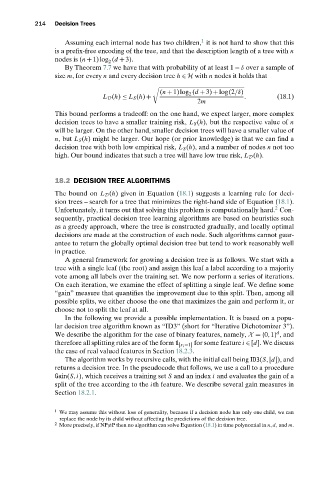Page 232 - Understanding Machine Learning
P. 232
Decision Trees
214
1
Assuming each internal node has two children, it is not hard to show that this
is a prefix-free encoding of the tree, and that the description length of a tree with n
nodes is (n + 1)log (d + 3).
2
By Theorem 7.7 we have that with probability of at least 1 − δ over a sample of
size m, for every n and every decision tree h ∈ H with n nodes it holds that
(n + 1)log (d + 3) + log(2/δ)
2
L D (h) ≤ L S (h) + . (18.1)
2m
This bound performs a tradeoff: on the one hand, we expect larger, more complex
decision trees to have a smaller training risk, L S (h), but the respective value of n
will be larger. On the other hand, smaller decision trees will have a smaller value of
n, but L S (h) might be larger. Our hope (or prior knowledge) is that we can find a
decision tree with both low empirical risk, L S (h), and a number of nodes n not too
high. Our bound indicates that such a tree will have low true risk, L D (h).
18.2 DECISION TREE ALGORITHMS
The bound on L D (h) given in Equation (18.1) suggests a learning rule for deci-
sion trees – search for a tree that minimizes the right-hand side of Equation (18.1).
2
Unfortunately, it turns out that solving this problem is computationally hard. Con-
sequently, practical decision tree learning algorithms are based on heuristics such
as a greedy approach, where the tree is constructed gradually, and locally optimal
decisions are made at the construction of each node. Such algorithms cannot guar-
antee to return the globally optimal decision tree but tend to work reasonably well
in practice.
A general framework for growing a decision tree is as follows. We start with a
tree with a single leaf (the root) and assign this leaf a label according to a majority
vote among all labels over the training set. We now perform a series of iterations.
On each iteration, we examine the effect of splitting a single leaf. We define some
“gain” measure that quantifies the improvement due to this split. Then, among all
possible splits, we either choose the one that maximizes the gain and perform it, or
choose not to split the leaf at all.
In the following we provide a possible implementation. It is based on a popu-
lar decision tree algorithm known as “ID3” (short for “Iterative Dichotomizer 3”).
d
We describe the algorithm for the case of binary features, namely, X ={0,1} ,and
therefore all splitting rules are of the form 1 [x i =1] for some feature i ∈ [d]. We discuss
the case of real valued features in Section 18.2.3.
The algorithm works by recursive calls, with the initial call being ID3(S,[d]), and
returns a decision tree. In the pseudocode that follows, we use a call to a procedure
Gain(S,i), which receives a training set S andanindex i and evaluates the gain of a
split of the tree according to the ith feature. We describe several gain measures in
Section 18.2.1.
1 We may assume this without loss of generality, because if a decision node has only one child, we can
replace the node by its child without affecting the predictions of the decision tree.
2 More precisely, if NP =P then no algorithm can solve Equation (18.1) in time polynomial in n,d, and m.

